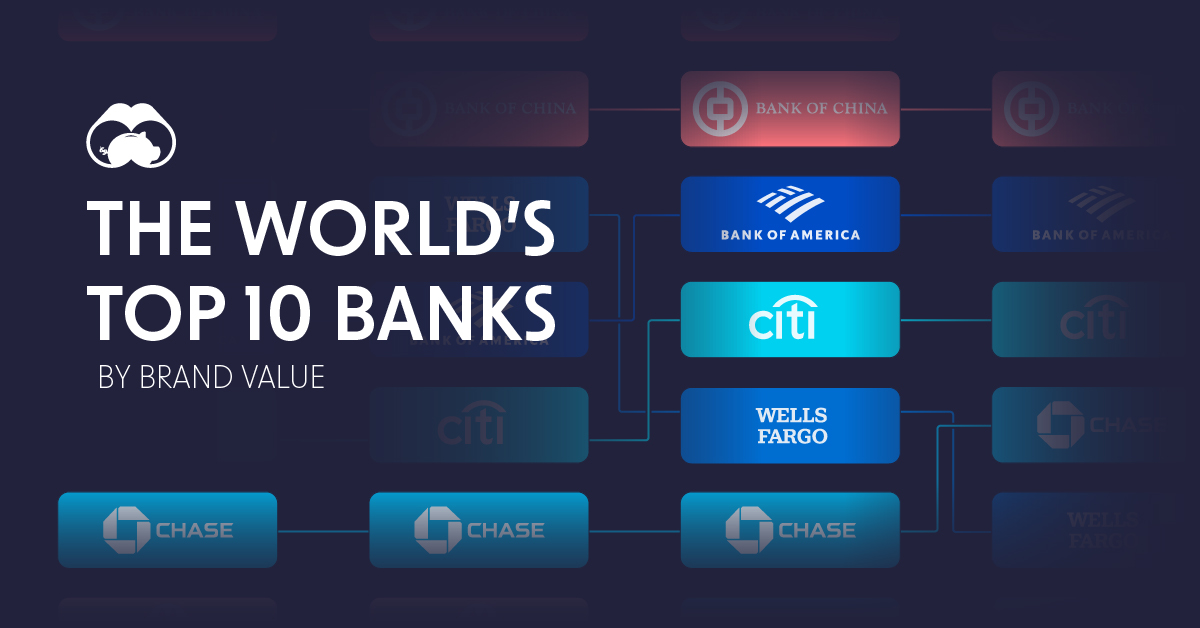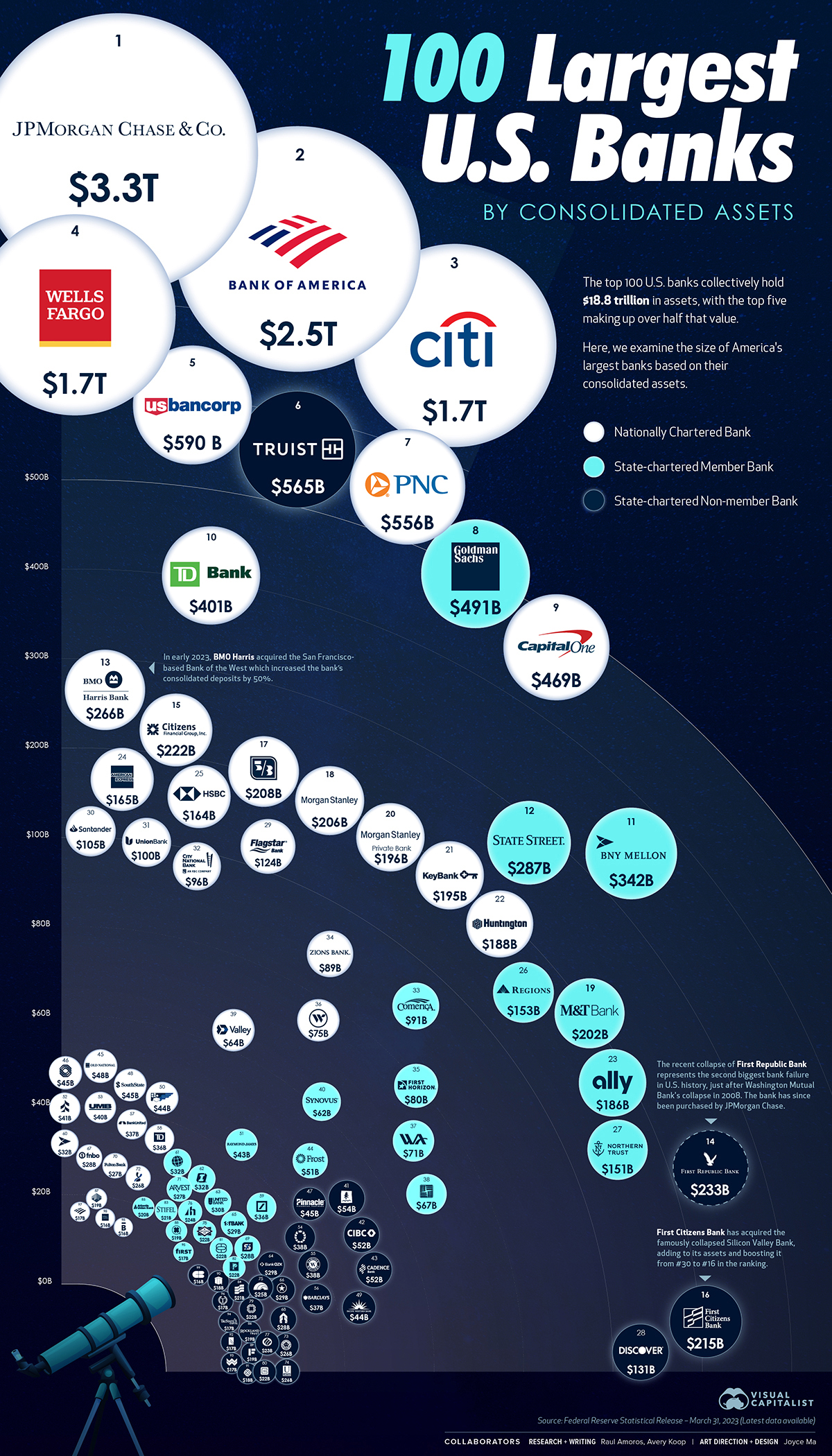Finance
Ranked: The World’s Most Valuable Bank Brands (2019-2023)
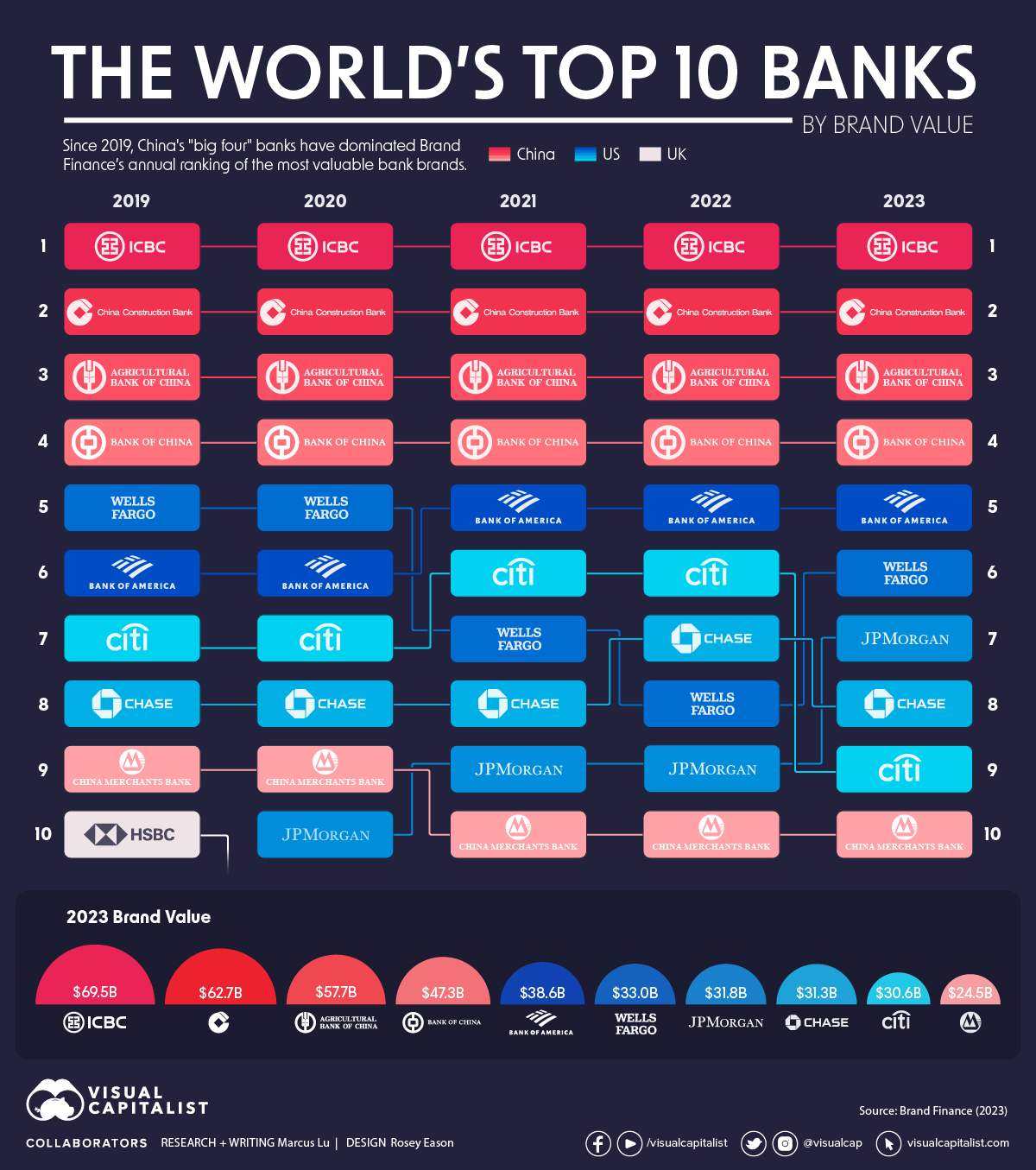
The World’s Most Valuable Bank Brands (2019-2023)
Since 2019, Chinese banks have held the top four spots on Brand Finance’s Banking 500—an annual ranking of the most valuable bank brands.
Brand value in this context is a measure of the “value of the trade mark and associated marketing IP within the branded business”. In other words, it measures the value of intangible marketing assets, and not the overall worth of the business itself.
In this infographic, we’ve visualized the Banking 500’s top 10 brands since 2019 to show you how the ranking has evolved (or stayed the same).
Top Bank Brands of 2023
The 10 most valuable bank brands of 2023 are evenly split between China and the United States. In terms of combined brand value, China leads with $262 billion to America’s $165 billion.
| Rank | Bank | Brand Value (USD billions) |
|---|---|---|
| 1 | 🇨🇳 ICBC | $69.5 |
| 2 | 🇨🇳 China Construction Bank | $62.7 |
| 3 | 🇨🇳 Agricultural Bank of China | $57.7 |
| 4 | 🇨🇳 Bank of China | $47.3 |
| 5 | 🇺🇸 Bank of America | $38.6 |
| 6 | 🇺🇸 Wells Fargo | $33.0 |
| 7 | 🇺🇸 JP Morgan | $31.8 |
| 8 | 🇺🇸 Chase | $31.3 |
| 9 | 🇺🇸 Citi | $30.6 |
| 10 | 🇨🇳 China Merchants Bank | $24.5 |
Chinese banks have a massive market to serve, which helps to lift the perceived value of their brands. For example, Industrial and Commercial Bank of China (ICBC) serves over 500 million individuals as well as several million business clients.
It’s worth noting that ICBC is the world’s largest bank in terms of assets under management ($5.5 trillion as of Dec 2021), and in terms of annual revenues ($143 billion as of Dec 2022). The bank was founded just 39 years ago in 1984.
After ICBC, the next three spots are occupied by the rest of China’s “big four” banks, all of which are state-owned.
The fifth to ninth spots on this ranking are occupied by an assortment of America’s largest banks. Despite a string of controversies in recent years, Wells Fargo rose from eighth in 2022 to sixth in 2023. This goes to show that large corporations can often recover from a scandal in a relatively short period of time (e.g. Volkswagen’s Dieselgate).
Coming in tenth is China Merchants Bank, which is China’s first “joint-stock commercial bank wholly owned by corporate legal entities”.
Top Asset Management Brands
Brand Finance’s 2023 ranking also includes a separate category for asset managers.
| Rank | Asset Manager | Brand Value (USD billions) |
|---|---|---|
| 1 | 🇨🇦 Brookfield | $9.0 |
| 2 | 🇺🇸 Fidelity | $8.4 |
| 3 | 🇺🇸 BlackRock | $6.6 |
| 4 | 🇺🇸 Blackstone | $4.9 |
| 5 | 🇨🇳 Cinda International Holdings Limited | $3.2 |
| 6 | 🇺🇸 Vanguard | $2.9 |
| 7 | 🇺🇸 Union Investment | $2.3 |
| 8 | 🇺🇸 Franklin Templeton Investments | $2.1 |
| 9 | 🇺🇸 Ameriprise Financial | $2.0 |
| 10 | 🇺🇸 Invesco | $1.5 |
Given America’s leadership in financial markets, it’s no surprise to see eight out of the 10 firms listed here as being based in the United States. The number one spot, however, is held by Canada’s Brookfield. The Canadian alternative asset manager is building a strong brand through its investments in renewable energy and other high-value infrastructure.
Markets
Visualized: The 100 Largest U.S. Banks by Consolidated Assets
In this visual we showcase the relative size of the 100 largest U.S. banks in terms of consolidated assets.
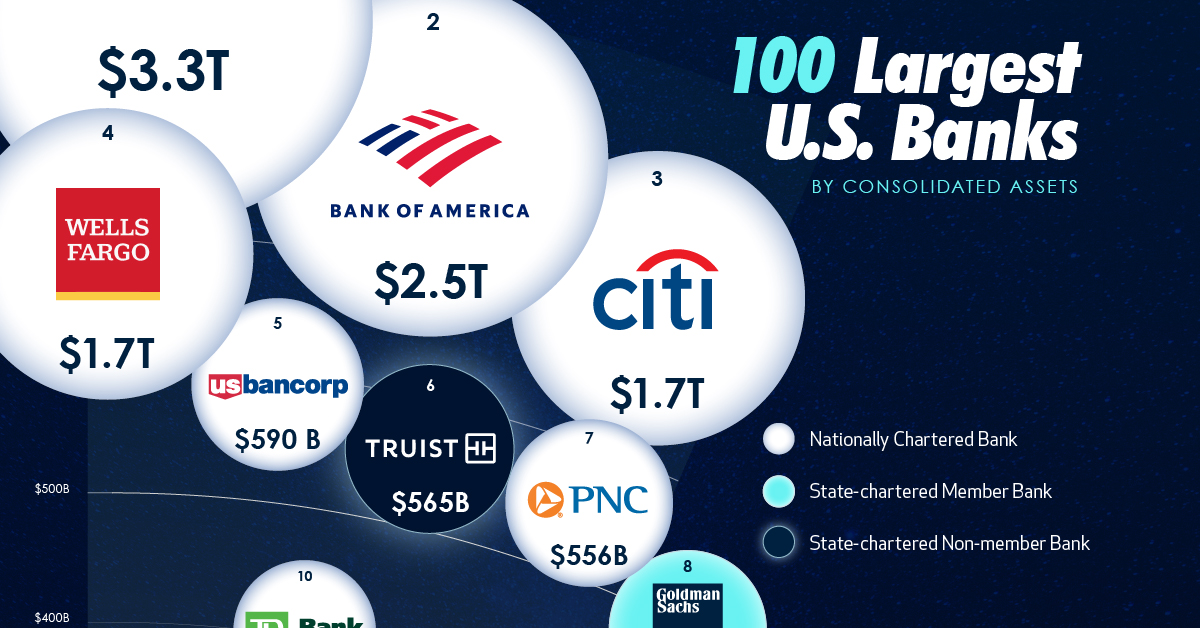
The 100 Largest U.S. Banks by Consolidated Assets
The largest 100 banks in the U.S. hold a combined $18.8 trillion in consolidated assets, but recent collapses of medium-sized banks like Silicon Valley Bank and First Republic have caused worries throughout the banking world.
This visual using data from the Federal Reserve ranks the country’s 100 largest banks by the size of their consolidated assets.
The Top 100 Banks
America’s biggest bank is JP Morgan Chase with over $3.3 trillion in assets, with Bank of America trailing behind in second place with $2.5 trillion. Here’s a closer look at the numbers:
| Rank | Bank / Holding Co Name | Consolidated Assets ($ Millions) |
|---|---|---|
| #1 | JP Morgan Chase Bank | $3,267,963 |
| #2 | Bank of America | $2,518,290 |
| #3 | Citibank | $1,721,547 |
| #4 | Wells Fargo | $1,687,507 |
| #5 | US Bancorp | $590,460 |
| #6 | Truist Bank | $564,837 |
| #7 | PNC Bank | $556,314 |
| #8 | Goldman Sachs | $490,799 |
| #9 | Capital One | $469,432 |
| #10 | TD Bank | $401,245 |
| #11 | Bank of NY Mellon | $341,455 |
| #12 | State Street | $287,069 |
| #13 | BMO Harris Bank | $265,446 |
| #14 | First Republic | $232,944 |
| #15 | Citizens Bank | $221,955 |
| #16 | First Citizens Bank | $214,599 |
| #17 | Fifth Third Bank | $207,586 |
| #18 | Morgan Stanely | $205,845 |
| #19 | Manufacturers and Traders Bank | $202,363 |
| #20 | Morgan Stanley Private Bank | $195,667 |
| #21 | Keybank | $195,191 |
| #22 | Huntington National Bank | $188,441 |
| #23 | Ally Bank | $186,383 |
| #24 | American Express | $165,450 |
| #25 | HSBC Bank USA | $164,492 |
| #26 | Regions Bank | $153,125 |
| #27 | Northern Trust | $150,573 |
| #28 | Discover Bank | $130,703 |
| #29 | Flagstar Bank | $123,633 |
| #30 | Santander Bank | $105,314 |
| #31 | MUFG Union Bank | $99,964 |
| #32 | City National Bank | $96,370 |
| #33 | Comerica Bank | $91,259 |
| #34 | Zions Bank | $88,574 |
| #35 | First Horizon Bank | $80,465 |
| #36 | Webster Bank | $74,793 |
| #37 | Western Alliance Bank | $70,986 |
| #38 | East West Bank | $67,219 |
| #39 | Valley National Bank | $64,314 |
| #40 | Synovus Bank | $61,726 |
| #41 | Umqua Bank | $53,986 |
| #42 | CIBC | $52,146 |
| #43 | Cadence Bank | $51,693 |
| #44 | Frost Bank | $51,286 |
| #45 | Old National Bank | $47,554 |
| #46 | BOK Financial | $45,269 |
| #47 | Pinnacle Bank | $44,988 |
| #48 | Southstate Bank | $44,903 |
| #49 | Pacific Western Bank | $44,255 |
| #50 | First National Bank of Pennsylvania | $44,132 |
| #51 | Raymond James Bank | $43,359 |
| #52 | Associated Bank | $40,653 |
| #53 | UMB Bank | $40,354 |
| #54 | Prosperity Bank | $37,829 |
| #55 | Hancock Whitney Bank | $37,525 |
| #56 | Barclays Bank | $37,352 |
| #57 | United Bank | $37,095 |
| #58 | TD Bank | $36,460 |
| #59 | Deutsche Bank | $36,103 |
| #60 | BNY Mellon | $31,945 |
| #61 | Commerce Bank | $31,853 |
| #62 | First Interest Bank | $31,565 |
| #63 | United Bank | $30,108 |
| #64 | Bank OZK | $28,971 |
| #65 | Firstbank | $28,764 |
| #66 | Texas Capital | $28,592 |
| #67 | First National Bank of Omaha | $28,393 |
| #68 | Glacier Bank | $27,785 |
| #69 | Simmons Bank | $27,538 |
| #70 | Fulton Bank | $26,996 |
| #71 | Arvest Bank | $26,946 |
| #72 | City National Bank of Florida | $26,204 |
| #73 | Ameris Bank | $25,991 |
| #74 | United Community Bank | $25,815 |
| #75 | First Hawaiian Bank | $24,883 |
| #76 | Bank of Hawaii | $23,904 |
| #77 | Eastern Bank | $22,702 |
| #78 | Centennial Bank | $22,452 |
| #79 | Washington Federal Bank | $22,320 |
| #80 | Cathay Bank | $22,016 |
| #81 | Customers Bank | $21,768 |
| #82 | Pacific Premier Bank | $21,362 |
| #83 | Stifel Banking and Lending | $20,969 |
| #84 | Bank of Hope | $20,564 |
| #85 | Atlantic Union Bank | $19,990 |
| #86 | Rockland Trust | $19,445 |
| #87 | Trustmark National Bank | $18,875 |
| #88 | Central Bancompany | $18,850 |
| #89 | DBA Independent Financial | $18,793 |
| #90 | First Merchants Bank | $18,165 |
| #91 | Mechanics Bank | $17,946 |
| #92 | Renasant Bank | $17,479 |
| #93 | Wesbanco | $17,237 |
| #94 | Tristate Capital Bank | $17,050 |
| #95 | First Financial Bank | $16,857 |
| #96 | Townebank | $16,730 |
| #97 | Bank of America | $16,550 |
| #98 | Wells Fargo | $16,473 |
| #99 | Citizens Bank | $16,271 |
| #100 | Bremer Bank | $15,763 |
The first and second place banks combined account for around 30% of the consolidated assets on this list. On the flip side, the smallest bank is Bremer Bank at $15.8 billion in consolidated assets. While this seems small in the context of this list, there are actually thousands of even smaller commercial financial institutions in the country.
Many banks have seen significant changes to their ranking since the last Fed data at the end of 2022. BMO Harris moved up 10 spots, going from $177 billion in consolidated assets to $265 billion—an increase of 50%. In February, the bank acquired the San Francisco-based Bank of the West (which previously ranked 34th on this list).
First Citizens also saw its rank improve, going from 30th to 16th, thanks to the acquisition of the remnants of Silicon Valley Bank.
In May 2023, a planned merger between First Horizon and TD Bank was mutually terminated. The merger, had it gone ahead, would have seen TD Bank surpass the size of Capital One.
Banking Heavyweights
Typically, big banks are less of a risk for borrowers in terms of their liquidity, holding huge sums in diversified assets, whereas smaller and more regional American banks have a narrower margin for error. However, many other factors beyond size play into risk, like an institution’s loan portfolio or management style.
Volatility in the banking sector is expected to have implications on the wider economy. For example, bank lending capacity is expected to decrease by 1% this year, a shift which the IMF expects will take almost half a percentage point off the U.S.’ overall GDP.
The largest banks have set aside billions in anticipation of bad loans as a result of pressure from rising interest rates. JP Morgan Chase currently has $2.3 billion in provisions/reserves built. Here’s a look at some of the current reserves that banks have set aside based on most recent data:
| Bank | Reserves Built / Reserves Released | As of |
|---|---|---|
| JP Morgan Chase | $2.3 billion | Q1 2023 |
| Wells Fargo | $1.2 billion | Q1 2023 |
| Goldman Sachs | $972 million | Q4 2022 |
| Citigroup | $241 million | Q1 2023 |
| Morgan Stanley | $234 million | Q1 2023 |
| Bank of America | $124 million | Q1 2023 |
Bank Volatility
Small and medium sized banks (<$250 billion in assets) play an important role in the economy. Collectively, these banks are responsible for 45% of consumer lending and 80% of commercial real estate lending.
However, lending by these banks has been tightening up, given the current economic conditions and fears around bank collapses.
Overall, continued turmoil in the banking sector would likely reduce profitability for banks and ultimately slow economic growth.
-

 Investor Education4 weeks ago
Investor Education4 weeks agoVisualizing BlackRock’s Top Equity Holdings
-

 Technology2 weeks ago
Technology2 weeks agoMeet the Competing Apps Battling for Twitter’s Market Share
-

 China18 hours ago
China18 hours agoHow Do Chinese Citizens Feel About Other Countries?
-

 Markets4 weeks ago
Markets4 weeks agoVisualizing Every Company on the S&P 500 Index
-

 Markets2 weeks ago
Markets2 weeks agoVisualizing 1 Billion Square Feet of Empty Office Space
-
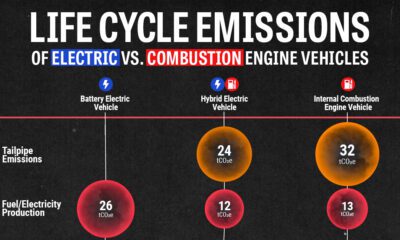
 Energy4 weeks ago
Energy4 weeks agoLife Cycle Emissions: EVs vs. Combustion Engine Vehicles
-

 History2 weeks ago
History2 weeks agoVintage Viz: The World’s Rivers and Lakes, Organized Neatly
-
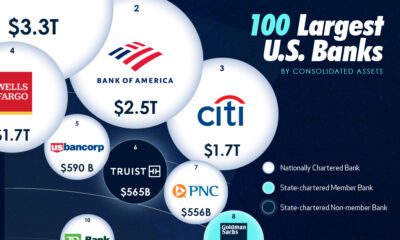
 Markets3 weeks ago
Markets3 weeks agoVisualized: The 100 Largest U.S. Banks by Consolidated Assets




